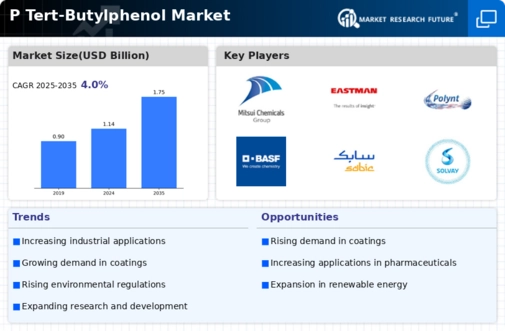Expansion of End-Use Industries
The P Tert-Butylphenol Market is significantly influenced by the expansion of end-use industries such as automotive, construction, and electronics. These sectors increasingly rely on P Tert-Butylphenol for its properties as a stabilizer and additive in various formulations. For instance, in the automotive industry, it is used in the production of rubber and plastics, which are essential for vehicle manufacturing. The construction sector also utilizes this compound in adhesives and sealants. As these industries continue to grow, the demand for P Tert-Butylphenol is expected to rise correspondingly, indicating a robust market trajectory. Market analysis suggests that the automotive sector alone is anticipated to witness a growth rate of around 5% annually, further bolstering the P Tert-Butylphenol Market.
Regulatory Support for Chemical Safety
The P Tert-Butylphenol Market benefits from increasing regulatory support aimed at enhancing chemical safety and environmental protection. Governments and regulatory bodies are implementing stringent guidelines that encourage the use of safer chemical alternatives and promote sustainable practices. This regulatory landscape is likely to drive innovation within the P Tert-Butylphenol Market, as manufacturers adapt to comply with new standards. Furthermore, the emphasis on safety may lead to increased investment in research and development, fostering the creation of advanced formulations that utilize P Tert-Butylphenol. As a result, the market could see a shift towards more sustainable production methods, potentially increasing the compound's appeal among environmentally conscious consumers.
Rising Demand in Chemical Manufacturing
The P Tert-Butylphenol Market is experiencing a notable increase in demand due to its essential role in chemical manufacturing processes. This compound is utilized as a precursor in the synthesis of various chemicals, including antioxidants and surfactants. As industries expand and innovate, the need for high-quality chemical intermediates rises, thereby propelling the demand for P Tert-Butylphenol. Recent data indicates that the chemical manufacturing sector is projected to grow at a compound annual growth rate (CAGR) of approximately 4.5% over the next five years. This growth is likely to enhance the market dynamics of the P Tert-Butylphenol Market, as manufacturers seek reliable sources of this compound to meet their production needs.
Technological Innovations in Production
Technological advancements in the production processes of P Tert-Butylphenol are poised to enhance efficiency and reduce costs within the P Tert-Butylphenol Market. Innovations such as improved catalytic processes and automation in manufacturing are likely to streamline production, thereby increasing output and reducing waste. These advancements not only contribute to cost-effectiveness but also align with the growing demand for sustainable manufacturing practices. As companies adopt these technologies, the overall competitiveness of the P Tert-Butylphenol Market may improve, attracting new entrants and fostering market growth. Industry expert's suggest that the integration of advanced technologies could lead to a reduction in production costs by up to 15%, further stimulating market dynamics.
Increasing Awareness of Environmental Impact
The P Tert-Butylphenol Market is witnessing a shift in consumer preferences driven by increasing awareness of environmental impacts associated with chemical products. As stakeholders become more conscious of sustainability, there is a growing demand for eco-friendly alternatives. This trend is prompting manufacturers within the P Tert-Butylphenol Market to explore greener production methods and formulations. Companies are likely to invest in research to develop P Tert-Butylphenol derivatives that minimize environmental footprints while maintaining performance. This shift not only aligns with consumer expectations but also positions the market favorably in the context of evolving regulatory frameworks. The potential for innovation in this area could lead to new product lines that cater to environmentally aware consumers, thereby expanding market opportunities.


















Leave a Comment